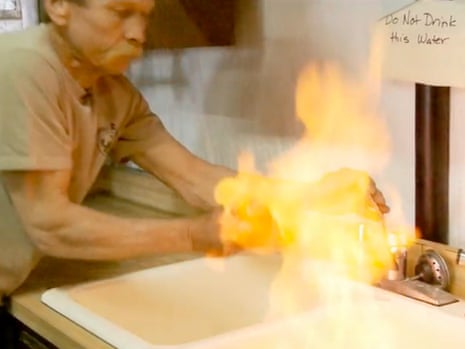The natural gas boom resulting from fracking has contaminated drinking water in Texas and Pennsylvania, a new study said on Monday.
However, the researchers said the gas leaks were due to defective gas well production – and were not a direct result of horizontal drilling, or fracking.
The study published in the Proceedings of the National Academy of Sciences validated some of the concerns raised by homeowners in the Barnett Shale of Texas and the Marcellus formation in Pennsylvania about natural gas leaking into their water supply.
The film Gasland notoriously showed flames bursting out of a kitchen tap because of high concentrations of natural gas in drinking water.
But the researchers said there was no direct causal relationship with fracking itself.
“Our data do not suggest that horizontal drilling or hydraulic fracturing has provided a conduit to connect deep Marcellus or Barnett formations directly to surface aquifers,” the authors wrote.
Instead, the researchers said the leakage was due to faulty cement casing on natural gas wells.
The finding was in line with a number of earlier studies on leaks in the cement casing of natural gas wells.
In Pennsylvania, state inspectors found about 9% of steel and cement casings on wells drilled since the start of the natural gas boom were compromised. There was an even higher risk on newer wells drilled since 2009, especially in the north-western part of the state, the inspectors found.
Scientists from Cornell University – who have often led research onto environmental problems associated with fracking – have said in the past the problems with well construction were due to installation as well as faulty cement mixing.
Earlier this year, the Cornell researchers also found higher rates of methane leakage from natural gas wells.
Researchers from Duke University meanwhile have suggested that the higher failure rate for hydraulically fractured (fracked) wells could be due to longer distances, or the horizontal orientation, which adds to pressure on the casing.
Monday’s study was conducted by scientists from Ohio State University,Stanford University, Dartmouth College, and the University of Rochester as well as Duke.
The researchers took water samples seven locations around gas drilling regions in the Pennsylvania and Texas, and analysed them for traces of methane gas.
In some cases, the gas come from shallow formations unrelated to fracking, but travelled up through the gas well and leaked into the groundwater from there because of faulty casing.

Comments (…)
Sign in or create your Guardian account to join the discussion